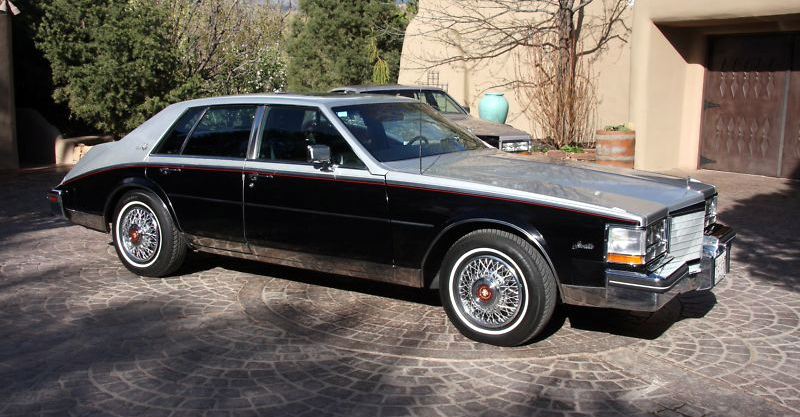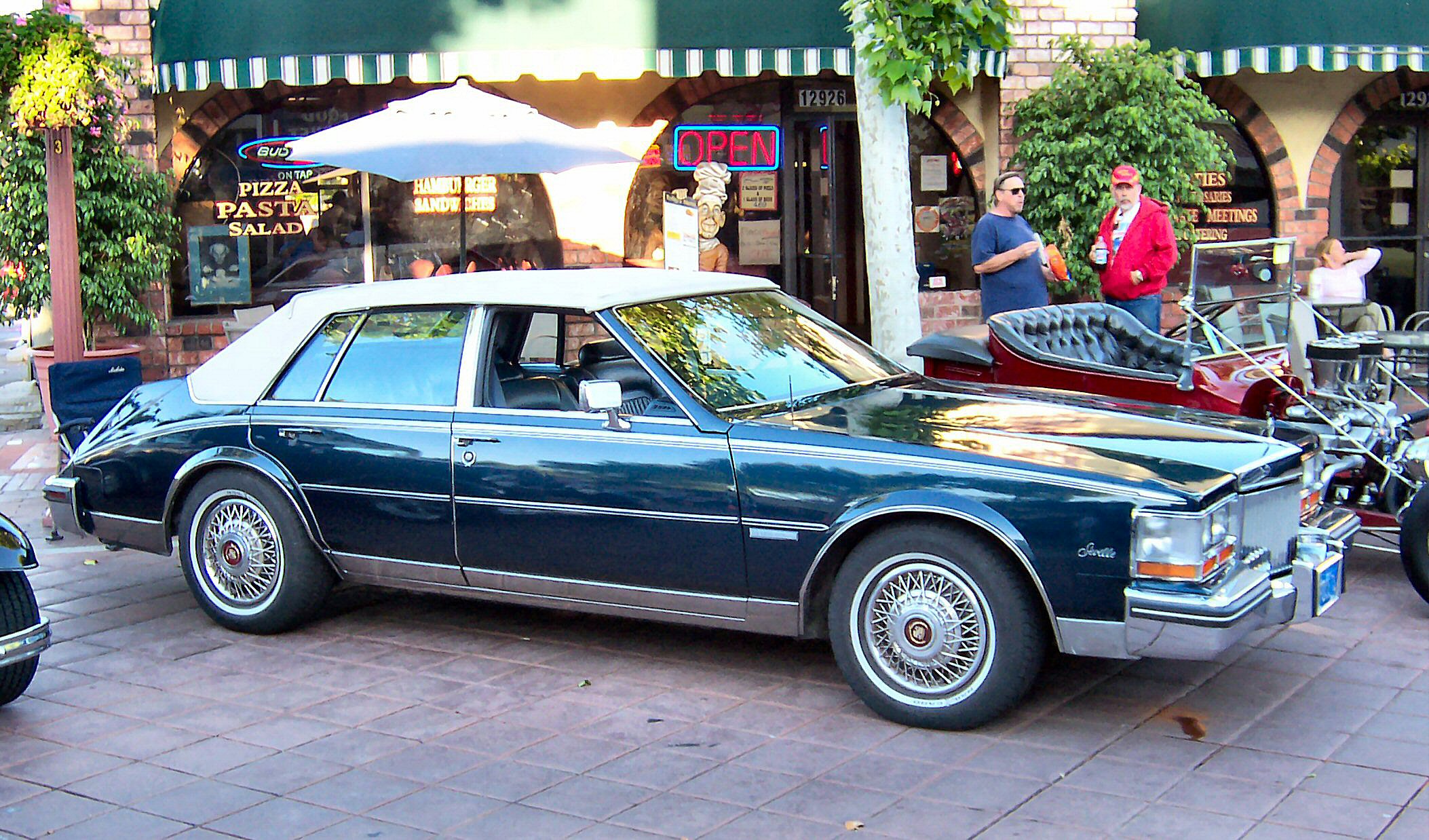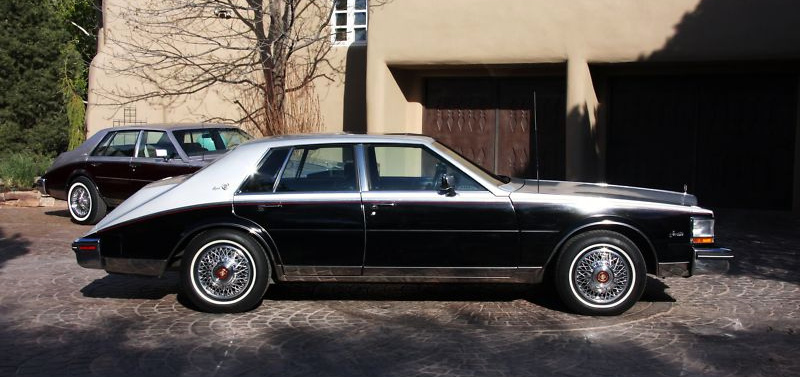Cadillac Seville
Cadillac Seville was the name of several passenger car model series of the car manufacturer Cadillac, which were produced between spring 1975 and late 2003.
The Seville- series were comparatively compact luxury vehicles that were smaller than the vehicles of the DeVille series, but at the same time were offered at significantly higher prices. They were technically related each other Group vehicles, but should give the impression of independence through individual drawn bodies.
Eldorado Seville (1956-1960)
In the 1950s the name Seville called the hardtop version of the Cadillac Eldorado.
Seville (1975-1980)
Cadillac Seville (1977-1980)
The background
The first series of the Cadillac Seville was introduced in May 1975. With it, General Motors responded to the increasing interest of the American clientele compact luxury vehicles. Outside reason for this was the oil crisis of the early 1970s. She had performed in the United States to a shift to smaller, more fuel-efficient vehicles that have been imported due to lack of local alternatives primarily from Europe and Japan.
Initially compact import models were only in the lower price segment successfully; but increasingly managed importers, but also occupy the high-priced area. There were German is primarily a producer who achieved success E3 technically advanced vehicles like the Mercedes -Benz " Stroke Eight " and the BMW. American manufacturers had the first nothing to oppose. General Motors recognized as the first of the big three American car companies a potential market for domestic models. This gap was filled in 1975 with the Cadillac Seville, which was 50 cm shorter and almost 450 kg lighter than the full-size models of the DeVille series and its dimensions so that corresponded approximately to the U.S. version of contemporary S- Class from Mercedes- Benz. The Seville could well establish regardless of its very high price in the U.S. market, without, however, the German import cars to outdo.
Two years later, Ford and Chrysler moved to the Lincoln Versailles or the LeBaron. However, they were not as successful as the Cadillac Seville by far. This was mainly due to the fact that both the Lincoln and Chrysler were only slightly modified middle class models, whose relationship was seen with the basic models without further notice. The Cadillac Seville was a contrast at least outwardly completely independent model, which seemed to have no apparent relationship with cheaper Group vehicles.
The term Seville goes back to the Spanish city of Seville. General Motors had originally contemplated to appoint Cadillacs small vehicle " Leland " (after Henry Martin Leland, the founder of the brand ). Of this distance, however, was soon taken, as it was feared that many of the younger buyers would not the name to assign or would instead produce an unwanted association with the British carmaker British Leyland.
Was envisaged also to revive the name LaSalle again, under which the cheaper models Cadillacs were marketed in the 1930s and 1940s. Also, this idea was not implemented; supposedly the name LaSalle had the "image of a loser ."
Model history
In developing the Cadillac Seville, the engineers were required to fall back on existing captive components. Initially, it was considered the " Cadillac Baby " dissipate from Opel Diplomat, which was driven in its highest quality trim level of an American eight-cylinder engine. However, this vehicle was not imported into the United States, so use German components would have required the costly rebuilding of parts supply in the U.S.. For cost reasons, this solution could therefore not be implemented. Instead, the X platform from General Motors was taken as the base, which has been used since 1968 in vehicles such as the Chevrolet Nova. This base was extensively revised; especially the chassis and the brakes have been adjusted to ensure that the small Cadillac should compete with German vehicles.
During test drives observers came to the conclusion that the Seville put the " best handling of a Cadillac in living memory" of the day: Although the Seville would not come closer to the performance of a Mercedes Benz 450 SEL, but he was also much cheaper.
The drive was initially a 5.7 liter ( 350 cubic inch ) large eight-cylinder engine, which was supplied by Oldsmobile. The engine was equipped with electronic fuel injection and made 180 hp.
With the beginning of the model year 1978 equal-sized diesel engine was available as an alternative, which was also made by Oldsmobile and 120 horsepower gave. The engine suffered significant reliability problems and was rarely ordered. The power transmission was standard with a three-speed automatic.
Unlike in the case of the later opponents of Lincoln and Chrysler, the Seville was an entirely independent body. The lines were in contrast to the sweeping forms of the DeVille series geradflächig and straightforward. Just the typical radiator grille with chrome grilles ( " Eggcrate - grille" or egg crate grill) made a reference to the brand Cadillac ago. In the first two years of Seville was only available with a vinyl -related roof. The coating should be a seam in the metal construction hide that it created, that the roof of two components separately prepared was put together: The front roof part corresponded to the inexpensive models of the X - bodies, while the rear roof part was produced exclusively for the Seville. Since many customers wanted to take the vinyl roof distance, Cadillac was forced in 1977 to produce a new, pressed into a coherent piece of roof for the Seville, which allowed one painted in body color.
The Cadillac Seville was one of the most expensive cars of American manufacture. In his presentation of the price of the basic version was $ 12,500. He was so - apart from the provided long-wheelbase Cadillac Seventy -Five Limousine - the most expensive Cadillac. He remained in this position until at the end of its production.
Over the years, in addition to the basic version of some special models that were sold at prices far higher arisen:
- This includes the Cadillac Seville Elegante, which was offered from 1978. He was characterized by an almost complete standard equipment and was outwardly recognizable by a two-tone paint.
Dissemination
The first series of the Cadillac Seville was a successful automobile. Although the production reached in any year even close to the level of full-size models DeVille and Fleetwood Brougham. However, the Seville was almost 50 percent more expensive than the standard models. In five years, Cadillac put forth more than 215,000 copies of Seville.
In the first production year 16,355 vehicles were produced in 1976 caused 43 772 vehicles. 1977 could produce 45 060 Cadillac Sevilles. The most successful model year was 1978, when nearly 57,000 vehicles were produced. In the last year of production 53 487 vehicles were produced again.
In Iran, the model from 1977 to 1980 was mounted by the company Iran General Motors under the model name Cadillac Civil.
Seville (1980-1985)
Cadillac Seville (1984 )
The Seville the second generation had a significantly more striking design than its predecessor, which mainly polarized the rear end. This Seville had front wheel drive and corresponded largely under the sheet metal to the then Cadillac Eldorado. The implementation began in the fall of 1980.
They had been created by Wayne Cady and should set the outgoing General Motors chief designer William Mitchell a monument. The rear roof line fell sharply. At the same time the trunk to the type of British upper class limousine was placed as it were. Cady quoting aware of a design feature, which fell to the British coachbuilding company Hooper. The design was controversial, but was active in the U.S. upper class temporarily influential - both the Lincoln Continental in 1982 as well as the Chrysler Imperial was introduced in 1981 possessed similar subscribed rear sections. The unusual lines of Seville was supported by a two-tone paint.
Offered was the Seville with a 5.7 -liter V8 diesel (78 kW, 1980-1985 ), the in-house 6.0 -liter V8 ( 104 kW, only 1980), known as the V8 -6- 4 variant the six- liter (108 kW, only 1981), Cadillac's new 4.1 -liter V8 ( 93-101 kW, 1982-1985 ) and also a 4.1 -liter V6 from Buick ( 93 kW, 1981/82 ).
Technical innovations such as the electric trunk closing assist, or electronic speedometer underlined Cadillacs status as an innovation leader, the vulnerable V8 -6- 4 engine in which the cylinder deactivation should reduce fuel consumption, failed, however, due to technical problems and was out after only one year taken the program.
From Seville the second generation left 198,000 pieces Cadillac bands.
Seville (1985-1991)
Cadillac Seville STS (1990 )
In autumn 1985, the Seville had changed fundamentally. It should be called with massive tail and steep rear window, the conservative form. For this, the entire body had become even more compact. This was possible because of Seville was the first production car in the world with a transversely mounted V8 engine. Capacity and performance of these third - generation Seville grew constantly; on the 4.1 liter V8, the 1986/1987 (97 kW ) was followed by 1988/1989, a 4.5 -liter V8 with 115 kW, which was launched in 1990 to 135 kW, and finally in 1991 a 4.9 -liter V8 with 149 kW.
From 1988, the Seville with the sport-touring sedan package ( briefly STS) was available, which provided strafferem with sports suspension for better road holding and attained the status of an independent model variant to the successor.
The American clientele was shrunk to just over 4.80 m Seville probably a size too small; sales continued to shrink to a total of 142,000 copies.
Seville (1991-1997)
Cadillac Seville (1991-1994)
The Seville fourth generation grew significantly, to 519 cm, and presented itself with a very modern, European-style body design. With this model Cadillac wanted to modernize the image of the brand.
In the program versions Seville Luxury Sedan ( SLS short ), the 1992/93 nor by the famous 4.9 -liter V8 with 149 kW ( 203 hp ), from 1994 to 1997 by a 204 kW ( 278 hp) version of the standing Northstar V8 was driven, and the Seville Touring Sedan ( STS ) with the 149 kW engine (Model 1992 ) or the 4.6 -liter Northstar, the 224 kW (304 hp) came here. A special feature of this Seville- generation was front-wheel drive with an automatic lock, which gave very good driving characteristics of the vehicle with the high engine power in the winter. The seating position could therefore be kept unusually low for a sedan.
In the Caddy hierarchy of Seville was with a length of 5.18 meters as a compact car, so he was almost European. Features such as self einschaltende headlights, automatically releasing the foot parking brake, self-closing trunk, auto-dimming interior mirror included even then the basic amenities expected in a Cadillac Seville.
In Europe, the Seville was compared because of its size, with common upper class sedans and offered due to the possible high motorway speeds only in the strongest and best-equipped version of STS. This had a stronger gearbox and oil cooler for engine, transmission and power steering. The weaker version of SLS with less equipment and a Breakaway at 200 km / h was like " gray " imports. However, the Seville had never compared the sales figures of the German competitors (Mercedes -Benz S- Class, BMW 7 Series ) a chance. In North America, however, priced positioned above the Cadillac DeVille, he could produce considerable sales success.
From the fourth generation Cadillac Seville produced a total of 247,000 copies.
Seville (1997-2003)
In the late summer of 1997 presented a new Cadillac Seville, which was technically related to the Oldsmobile Aurora. Externally, the new model was very similar to its predecessor, but waited with a plethora of changes in technology and chassis on. Again were a SLS and a STS on offer, 205 and 224 kW strong. From the beginning, both Seville models received the active suspension Magnetic Ride.
The production of the STS ended in May 2003, which of the SLS in December 2003. Successor of Seville is the only STS -called car with rear wheel drive.










